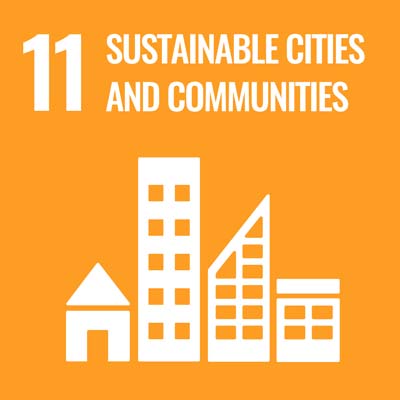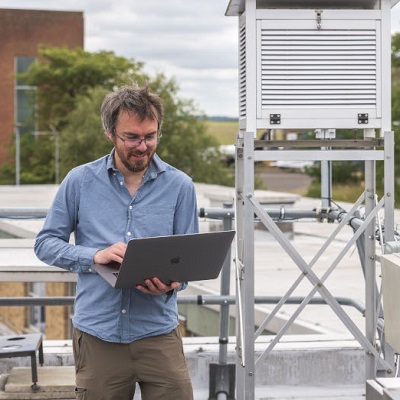The eleventh Sustainable Development Goal is to make cities and human settlements inclusive, safe, resilient and sustainable.
2023 progress report
Infrastructure
A new multi-million-pound antenna, radar and wireless communications facility will help businesses in the region test and develop new radio frequency products, with expected applications in aerospace, healthcare, space and mobile telecommunications.
The National Drone Innovation Gateway is a facility led by Cranfield University, Neuron Innovations and Ebeni to support innovators in the UK Drone and Urban Air Mobility (UAM) ecosystems. In 2023, the Gateway was proud to support Connected Places Catapult with their Future of Air Mobility accelerator.
To address the University’s new target to reduce water consumption by 50% by 2030, water use has been reduced by eliminating leaks through replacing aging pipework and working alongside the Living Lab project to invest in metering and encouraging behaviour change.
Research
Examples of research addressing this goal included:
- DAFNI, a computing platform to support research into national infrastructure, including transport, water and energy and city scale modelling. It represents an £8 million investment from the UK Collaboratorium for Research on Infrastructure and Cities (UKCRIC).
- The ongoing Defragmenting the fragmented urban landscape (DEFRAG) project which aims to connect the green and blue spaces that support biodiversity and ecosystem functioning for healthier, more resilient towns and cities.
- A study led by Cranfield and Leeds universities, and funded by UKCRIC, investigated the extent to which residents of the Oxford-Cambridge Arc support alternative green infrastructure funding mechanisms and where they believe these sources should come from.
- Constructing a Digital Environment Strategic Priorities Fund programme was completed in 2023. It aimed to develop a digitally enabled environment for scientists, policymakers, businesses, communities and individuals by creating integrated networks of sensors and the methodologies and tools for assessing, analysing, monitoring and forecasting the state of the natural environment.
- Biomineralisation for resource recovery aims to recover nutrients from wastewater, urine and other waste streams for reuse in agriculture and other industries, using the biomineralisation capability of specific bacteria.
- Mobility as a Service: Managing Cybersecurity Risks across Consumers, Organisations and Sectors (MACRO) concluded during 2023. It aimed to develop the world's first agent-based modelling framework explicitly focused on the cyber security aspects of the MaaS ecosystem.
Outreach
The 2023 Cranfield alumni conference focused on 'A resilient future: Building organisational and societal resilience', including an address from Lord Toby Harris, Chair of the National Preparedness Commission, President of the Institute of Strategic Risk Management, and Visiting Professor of Resilience at Cranfield University.
The Cranfield Sustainability group hosted a panel discussion to explore where the beer industry is in their race to net zero.
2022 progress report
Infrastructure
Our Living Lab and Urban Observatory form part of a £3.1m UK Research Partnership Investment Fund (UKRPIF) project. The new Net Zero Airport project will support steps to decarbonise aviation and is part of the Urban Observatory. The funding will enable further expansion of the sensor network, supporting the development of an airport 'digital twin' and a net zero sensor testbed. An example activity in this project looked at drone noise.
Education
Specific education programmes begun in 2021/22 included Protecting Critical National Infrastructure, which outlines current risks to critical infrastructure and key resources posed by terrorism and related threats; and Risk, Crisis and Resilience.
Research
Specific research projects addressing sustainable cities and communities included:
- Defragmenting the fragmented urban landscape (DEFRAG), which aims to connect the green and blue spaces that support biodiversity and ecosystem functioning for healthier, more resilient towns and cities.
- Mobility as a service (MaaS) develops the concept of a user unified service that combines various forms of transport at a single gateway. If successful, the project will lead to reduction of traffic congestion, improvement of customer convenience, reduction of social inequalities and carbon emissions by fostering the use of public transport.
- Integrating drones in urban airspaces – in the near future city-dwellers can expect to see a variety of drones in the airspace above where they live, perhaps transporting patients to hospitals, helping tackle fires, or simply delivering parcels. This vision of urban air mobility (UAM), making use of different types of drones, will also help people travel faster and more efficiently through unmanned air taxis – and researchers say it will be in place in a matter of a few years.
- A new European project, AMU-LED, is now carrying out co-ordination and substantial testing to manage this airspace traffic and check safety, interoperability and feasibility. The first trial demonstration took place at Cranfield University on 30 June, and will be followed by other trial events in the Netherlands and Spain.
Outreach
Our Sustainability Network series included a webinar focused on citizens and their needs.
Siqi Xu, a Cranfield student on the WIRe doctoral training programme, participated in the 2022 Milton Keynes Soapbox Science event where she spoke to the public about her research on sewage sludge.
New businesses
CorrosionRADAR, originally spun out by a Cranfield PhD student, went from strength to strength in 2021/22. The company’s vision is to provide owners of critical infrastructure in the energy industry with the data they need to proactively manage their corrosion challenges and make well informed decisions with regards to the integrity of their assets.
2021 progress report
Our aim is to provide a sustainable environment in which to live and work, both at the University campuses and other areas affected or influenced by our activities.
See our policies and plans for a sustainable community.
Cranfield's major refurbishments and new buildings are constructed with Building Research Establishment Environmental Assessment Method (BREEAM)'s standards in mind.
Our 'Masterplan' is available for staff to view on our intranet. It sets out the framework for any long-term investment in infrastructure.
Examples of new facilities opened in 2021 and built with BREEAM's standards in mind include DARTeC, a new facility to help drive forward innovations in digital airspace and airport infrastructure that will help the UK reach its target of net zero carbon emissions and support industry to bounce back from Covid-19; a new agri-informatics facility that will play a vital role in bringing forward digital innovations in agriculture; a leading national water science facility, the Water Science Building, funded by government through UKCRIC (the UK Collaboratorium for Research on Infrastructure and Cities) and Cranfield University; and a new forensic science ‘centre of excellence’ provides facilities in crime scene investigation, digital forensic investigation and forensic materials analysis, amongst others.
Courses/modules relating to the goal
The following courses either address sustainability entirely or contain modules that are focused on sustainability-related topics.
Advanced Digital Energy Systems MSc
Advanced GIS and Remote Sensing MSc
Advanced Lightweight and Composite Structures MSc
Advanced Materials MSc
Advanced Mechanical Engineering MSc
Advanced Motorsport Engineering MSc
Advanced Motorsport Mechatronics MSc
Aerospace Dynamics with options in Aerodynamics and Flight Dynamics MSc
Aerospace Manufacturing MSc
Aerospace Vehicle Design MSc
Air Transport Management Executive MSc
Air Transport Management MSc
Aircraft Engineering MSc (Engineering and Manufacturing streams)
Airport Planning and Management MSc
Airworthiness MSc
Applied Artificial Intelligence
Automotive Engineering MSc
Automotive Mechatronics MSc
Autonomous Vehicle Dynamics and Control MSc
Aviation Digial Technology Management MSc
Computational Fluid Dynamics MSc
Connected and Autonomous Vehicle Engineering MSc
Counterterrorism MSc
Counterterrorism Risk Management and Resilience MSc
Design Thinking MDes
Environmental Engineering MSc
Environmental Management for Business MSc
Executive MBA
Explosives Ordnance Engineering MSc
Food Systems and Management MSc
Future Food Sustainability MSc
Logistics and Supply Chain Management MSc
Management and Corporate Sustainability MSc
Management and Entrepreneurship MSc
Management and Human Resource Management MSc
Management MSc
MBA
Procurement and Supply Chain Management MSc
Renewable Energy MSc
Sustainability MSc
Thermal Power and Propulsion MSc
Through-life System Sustainment MSc
Water and Wastewater Engineering MSc



